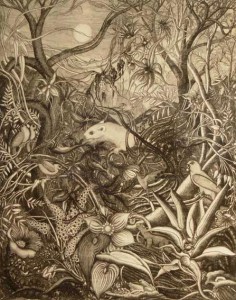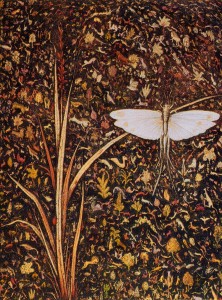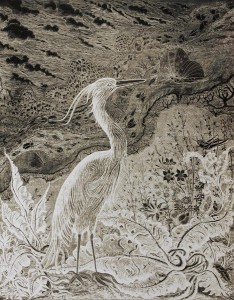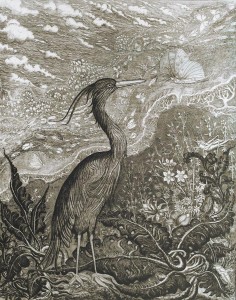Solberg’s Engravings are populated with prowling rodents, sharp-billed herons, snow-white stoats gnawing into the thickets – a whole wriggling world materializing the gestures of the engraver who cuts, rips, corrodes the metal. Solberg nibbles at her copper plate with the stubbornness of a shrew, her tools have the diligence of the tiny creatures scurrying around under the foliage.
Here, the ground is still a garden, an Eden of lianas and lines, but the drawing, although meticulously detailed, is not in a shamble. The grass leaves are as sharp as barbed wire, and as jovial as brambles. Seeing this, Hector Guimard, the designer of the Paris métro entrances around 1900, would eat his hat, green with jealousy.
Sometimes a fleeting hero, a wading bird, a humble dormouse or an evening butterfly will be in the center of the view on vegetation. It opposes the silk of its skin or the arrangement of its wings to the hullabaloo which surrounds it. I know an Isabelle strutting on a bulrush, with the grace of gentle ladies walking their hennin in front of “thousand flowers”-style of medieval tapestries.
Is this the smell of ink? One can easily imagine that these wild territories have tuberose fragrances. A few noises can be heard.
How to look at an engraving by Solberg without seeing and hearing the title theme La Vie des animaux (“The Life of Animals”), a noted TV series of the Sixties.
The notes of the lounge music by Les Baxter, exotic, hypnotic, punctuated with animal cries: as a child, I could not hear this “quiet village” without getting goose flesh, especially when the images went on to show eerie pairs of eyes.
It showed a procession of stylized drawings of owls, armadillos and marabou storks etc. in white on a black background as these so-called “frosted” engravings Solberg is fond of, one of which is precisely entitled The Exploded Ear.
Precisely, in Solberg’s world, there is always an eye which gazes or cries, but instead of a tear, a dewdrop oozes; instead of a hem of eyelashes, it is the beat of shivering stamina. In the flowers, pupils ignite, and nature palpitates with all these hearts and looks at us through these countless eyes.
Christine Sourgins, art historian.



